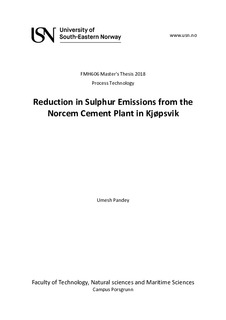| dc.description.abstract | SO2 emissions in the stack gas from the Norcem cement plant in Kjøpsvik was significantly higher than the permitted emission limit in 2017. The plant aims to reduce the emissions by installing a seawater flue gas desulphurization (SWFGD) technology, but an understanding of sulphur behaviour in the kiln process, identification of critical factors, determination of their impact and describing underlying principle behind their effects in the emissions are beneficial for future plant and SWFGD operation. This report presents an analysis of the SO2 emission characteristics in the kiln based on sulphur material balance, and regression model formulation using historical emission data and kiln tests. Analysis of the historical data shows that SO3 content in the kiln feed and rawmill operation mode are the most significant parameters which vary sulphur emission in the stack gas. In the analysis, it was discovered that bypass water supply, tyre feeding, RDF feeding, coal feeding and energy input per unit ton of clinker from rotary kiln fuels influence the emissions from the plant. Kiln tests varying these parameters were performed to determine the impact of these parameters on the emissions. The results from the kiln tests show that tyre and RDF feeding have the most significant positive impact while rawmill feed had a negligible impact on the SO2 emissions. During the kiln tests, CO level in the kiln inlet was significantly higher with both tyre and RDF feeding and subsequently caused higher emissions. Moreover, the sulphur flow in the hotmeal and rotary kiln gases were considerably higher with both tyre and RDF feeding resulting in higher sulphur flow in the stack gas and lower sulphur flow in the clinker. Coal feeding in the kiln inlet shows a positive impact on the SO2 emissions indicating that the decrease in coal feeding (increase in waste oil feeding) reduces SO2 emissions from the plant. The positive effects of coal feeding in the kiln inlet could be related to relatively slow and inefficient combustion of coal in comparison to the waste oil thereby causing reducing environment in the kiln. Based on the coefficient value in the model, kiln feed shows a negligible negative impact on the emissions, however, individual investigations show increased emissions with higher kiln feed due to reduced O2 level in the kiln inlet. A similar type of discrepancy between regression model coefficients and individual test assessment was seen in the case of energy input rate from the rotary kiln fuels. Although regression model showed a negligible negative impact, higher emission was observed in the test with energy input rate from rotary kiln fuels at high-levels. Sulphur flow in the bypass gas was significantly higher in the test with energy input rate from rotary kiln fuels indicating that sulphur flow in the bypass gas primarily controls the SO2 emissions in the tests with higher thermal load in the kiln. Other parameters, bypass water supply and rawmill feed, showed a negligible impact on the emissions variations. Most of the experimental observations and subsequent analysis are affected by the faulty hotdisc operation, lack of perfect orthogonality in the experimental matrix, and fewer numbers of the test run, hence further kiln tests along with spot analysis of different gas streams are recommended to determine exact impacts of these parameters on the emissions variations. | nb_NO |
